The Williams %R indicator holds valuable insights for traders aiming to navigate market dynamics adeptly. Delving into the intricacies of this tool can unveil a realm of potential benefits. By strategically adjusting periods and avoiding simplistic trading decisions based solely on extreme readings, traders can harness the true power of Williams %R.
However, these are just the initial steps, as there are further layers to explore in conjunction with other indicators and trading strategies. The path to mastering Williams %R entails a multifaceted approach that demands attention to detail and a nuanced understanding of market nuances.
Understanding Williams %R Indicator
The Williams %R Indicator, an essential tool in technical analysis, provides traders with valuable insights into market conditions by measuring the proximity of the current price to recent highs and lows. Developed by Larry Williams, this oscillator is widely used in trading to identify overbought and oversold conditions.
With a scale ranging from 0 to -100, Williams %R helps traders determine whether an asset is trading close to its recent high or low. High Williams %R values indicate potential overbought conditions, suggesting that the price may be nearing a reversal or correction. Conversely, low Williams %R values signal potential oversold conditions, indicating that the price may be due for a bounce back.
Setting the Right Timeframe
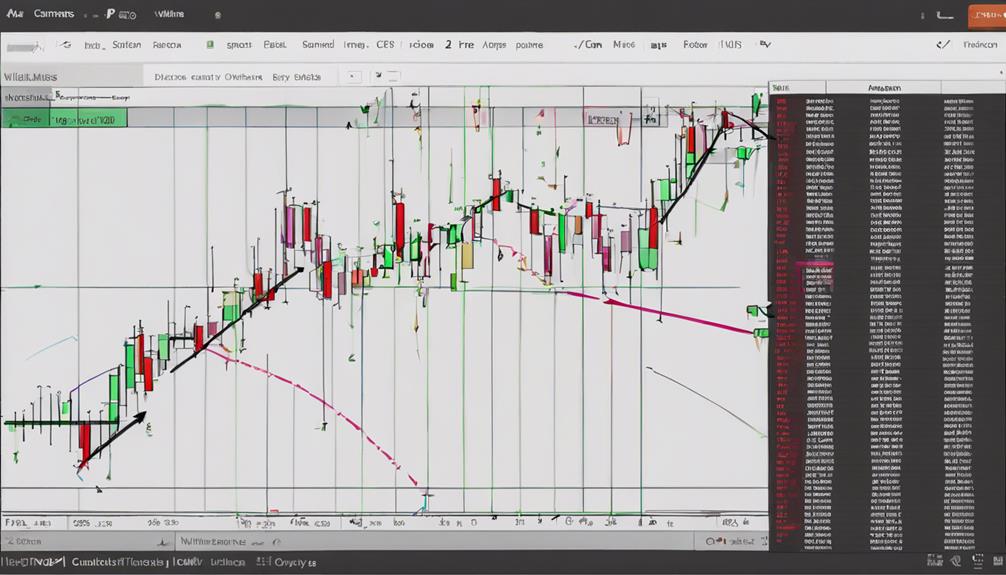
Selecting the appropriate timeframe when using the Williams %R indicator is crucial for optimizing its performance. Different timeframes can impact the indicator's sensitivity and responsiveness to market changes.
Understanding how to analyze, adjust, and fine-tune the timeframe can significantly enhance the effectiveness of this technical analysis tool.
Optimal Timeframe Selection
When determining the optimal timeframe for utilizing the Williams %R indicator, it is crucial to consider the desired level of sensitivity or smoothness in signal generation. Shorter timeframes, like 10 periods, offer more sensitive signals suited for quick trades, while longer timeframes, such as 20 periods, can smooth out noise but may lag in indicating market changes. Tailoring the timeframe selection to the volatility of the asset and your trading style is essential.
It's advisable to experiment with various timeframes to identify the one that best aligns with your trading strategy and risk tolerance. Finding the right balance between sensitivity of signals and smoothness can significantly impact the effectiveness of using the Williams Percent Range indicator.
Timeframe Impact Analysis
Analyzing the impact of different timeframes on the Williams %R indicator provides valuable insights into optimizing signal accuracy and noise reduction in market analysis.
- Timeframe selection: Determines the sensitivity of %R readings to price changes.
- Market conditions: Influence the frequency of overbought and oversold signals.
- Signal accuracy: Shorter timeframes offer more frequent signals, while longer ones provide a broader perspective.
- Noise reduction: Experimenting with timeframes helps find the right balance.
- Adaptation: Adjusting timeframes based on trading strategies and market volatility can enhance decision-making processes.
Timeframe Adjustment Strategies
To effectively optimize the Williams %R indicator for market analysis, strategic adjustment of the timeframe is crucial in aligning sensitivity to price movements with trading objectives and risk tolerance.
Shorter timeframes, like 5 or 10 periods, enhance responsiveness to recent price changes, aiding in identifying short-term trends. On the other hand, longer timeframes, such as 20 or 30 periods, provide a smoother analysis of price fluctuations but may delay signaling potential reversals.
Traders should experiment with various timeframes to tailor %R to their specific trading style and goals. The selection of the optimal timeframe for Williams %R hinges on individual risk tolerance levels, prevailing market conditions, and the overall trading strategy employed.
Identifying Overbought and Oversold Conditions
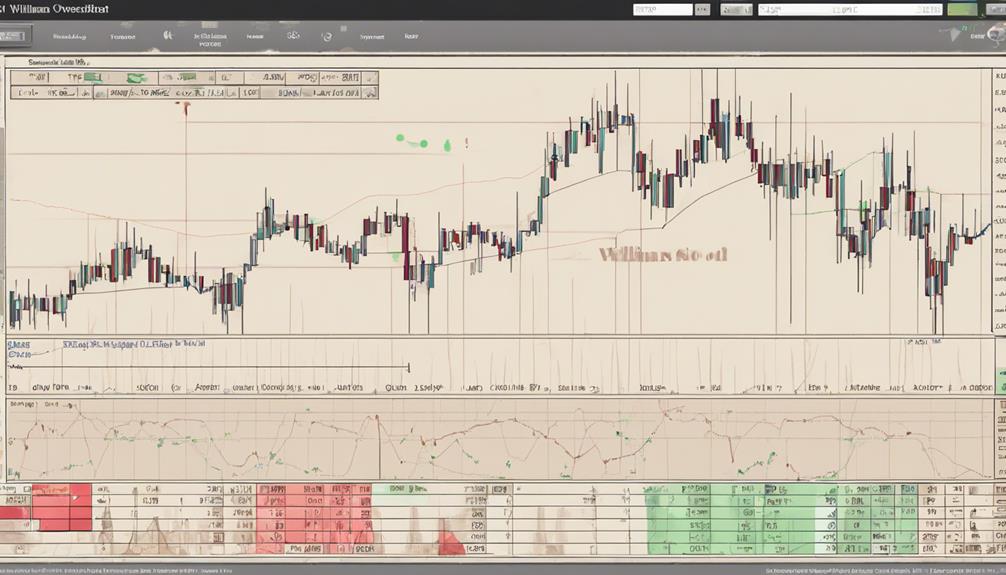
Identifying overbought and oversold conditions using the Williams %R indicator is crucial for traders seeking profitable entry and exit points in the market. Overbought conditions are indicated when the Williams %R readings surpass -20, while oversold conditions are identified by readings falling below -80.
Recognizing these extreme %R values can provide insights into potential price reversals and help traders make informed decisions based on market sentiment and momentum shifts.
Overbought Signals Explanation
When observing the Williams %R indicator, surpassing the -20 level signifies overbought conditions, indicating a potential shift towards price exhaustion at elevated levels.
- Overbought conditions in Williams %R signal potential price exhaustion at higher levels.
- Traders see overbought signals as a warning of a possible market reversal.
- Williams %R above -20 suggests the current price is near recent highs, potentially indicating a selling opportunity.
- Combining overbought readings with other indicators can confirm trend changes.
- Identifying overbought signals using Williams %R assists traders in making informed decisions about market extremes.
Oversold Signals Definition
After discussing overbought signals in the Williams %R indicator, it is important to define oversold signals to complete the understanding of identifying overbought and oversold conditions.
Oversold conditions are indicated when Williams %R falls below -80, suggesting potential buying opportunities. Traders use these signals to anticipate price reversals or bounces in the market. When Williams %R is below -80, it signifies that the security's price is nearing the lower end of its recent range.
To make informed trading decisions, traders often seek confirmation signals when Williams %R enters oversold territory. Understanding oversold signals with Williams %R can help traders identify entry points for potential uptrends or reversals.
Using Reversal Patterns
Utilization of reversal patterns is a key strategy in analyzing overbought and oversold conditions with the Williams %R indicator. When using this indicator, traders can capitalize on potential trend reversals and make strategic trading decisions.
Here are some crucial points to consider:
- Identifying overbought and oversold conditions based on Williams %R readings above -20 and below -80.
- Looking for reversal patterns when Williams %R crosses above -20 for possible pullbacks in overbought territories.
- Recognizing oversold conditions when Williams %R falls below -80, signaling a potential bounce or reversal.
- Noting extreme levels in Williams %R as they can indicate upcoming trend reversals or corrections.
- Enhancing accuracy by combining Williams %R with other indicators for a comprehensive analysis.
Incorporating Williams %R With Other Indicators
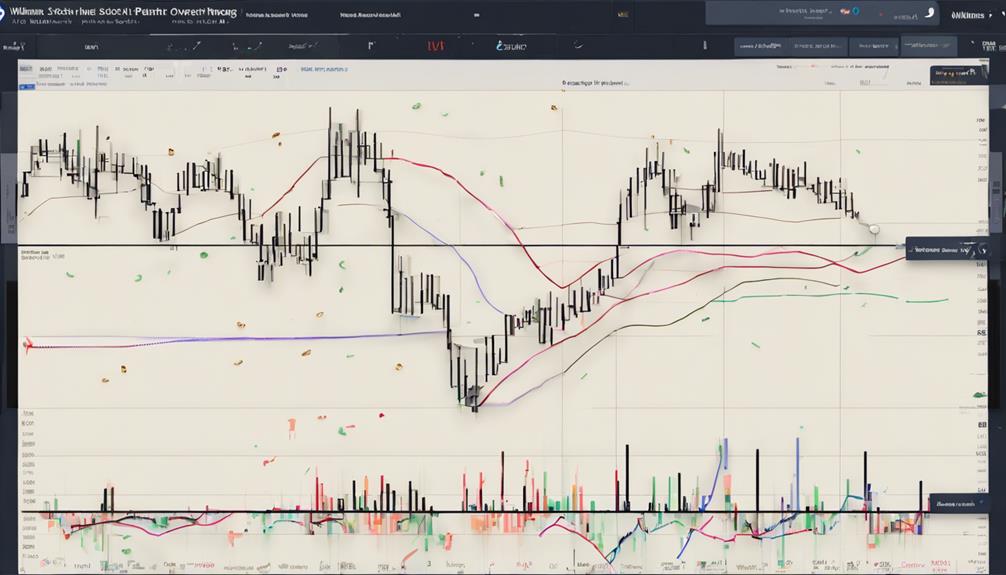
By integrating Williams %R with various other technical indicators, traders can gain valuable insights into market trends and potential trading opportunities. Combining Williams %R with moving averages can help confirm trend direction and pinpoint potential reversal points.
When used alongside the Relative Strength Index (RSI), Williams %R can provide additional information on overbought or oversold conditions, aiding in decision-making. Incorporating Williams %R with Bollinger Bands enables traders to identify volatility levels and potential breakout points more effectively.
Pairing Williams %R with the Moving Average Convergence Divergence (MACD) indicator offers a comprehensive view of both momentum and trend strength, allowing for a more holistic analysis. Furthermore, utilizing Williams %R in conjunction with support and resistance levels can enhance the precision of determining optimal entry and exit points in the market.
Implementing Effective Trading Strategies

To enhance trading success and maximize profitability, implementing effective strategies based on sound analysis and strategic decision-making is crucial in the dynamic financial markets. When utilizing the Williams %R Strategy, traders can benefit from the momentum indicator to determine entry and exit points effectively. Here are some key points to consider:
- Utilize the -50 line cross in Williams %R to identify momentum shifts and potential trading opportunities.
- Look for divergences between price and %R for trend continuation signals in your trading strategy.
- Identify entry points by monitoring Williams %R breaking below -20 and staying below -30 for trend following.
- Combine price action analysis with Williams %R signals to enhance trading accuracy and decision-making.
- Exercise caution with immediate buy or sell signals based on overbought or oversold conditions, and consider using a comprehensive approach with other technical indicators.
Utilizing Williams %R for Trend Confirmation
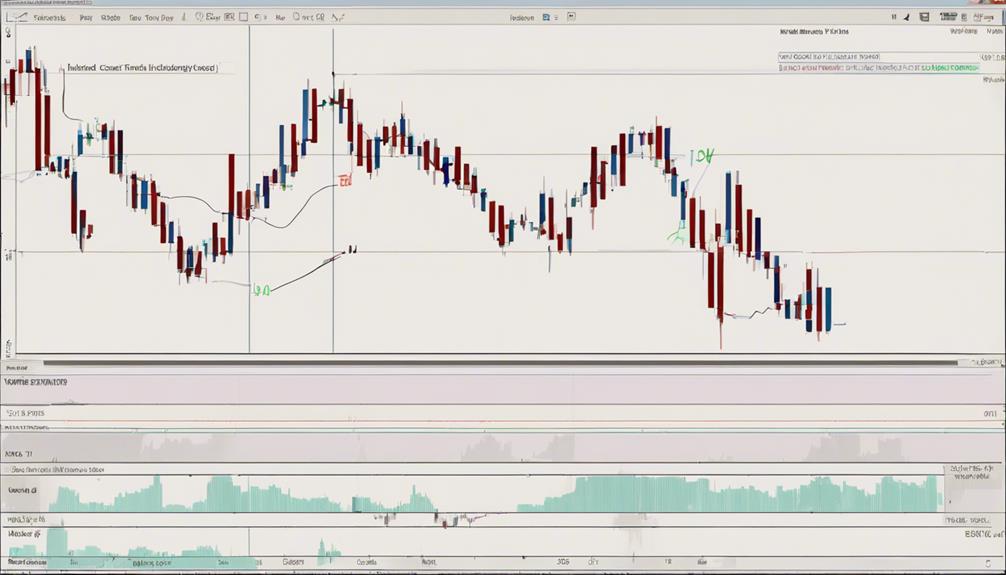
When considering trend confirmation in trading strategies, an essential tool to leverage is the Williams %R indicator. This indicator helps confirm trends by identifying overbought conditions when it rises above -20 and oversold conditions when it falls below -80.
To validate trend direction, traders should wait for Williams %R to cross these key levels. It is crucial to use Williams %R in conjunction with other indicators to strengthen trend confirmation signals.
Trend confirmation occurs when Williams %R aligns with price movements, indicating momentum in the market. For enhanced accuracy, combining Williams %R with moving averages can provide a more comprehensive view of the trend.
Managing Risk With Williams %R
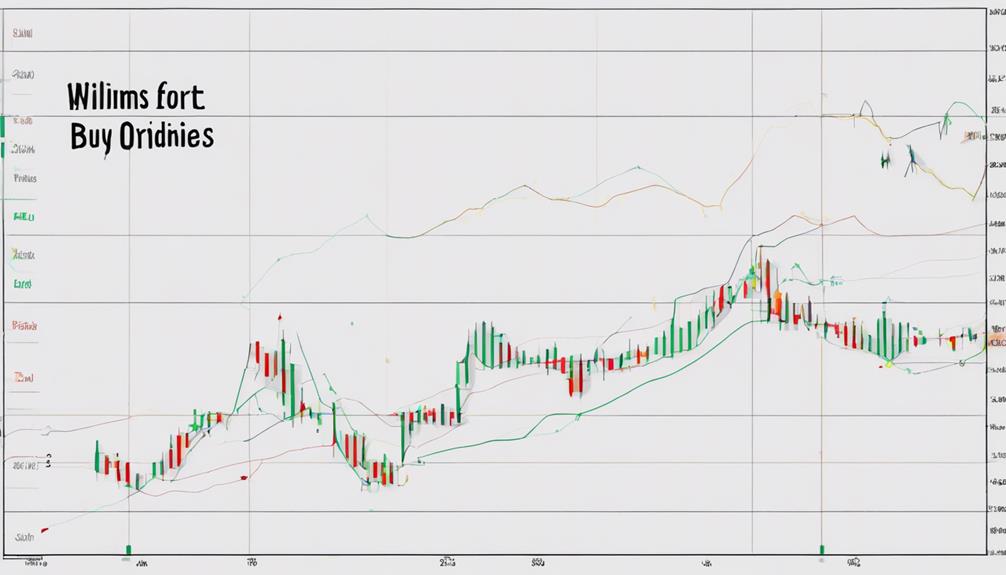
In risk management, leveraging the insights provided by the Williams %R indicator can significantly enhance a trader's ability to navigate volatile market conditions and make informed decisions. The Williams %R indicator can be a valuable tool for managing risk in trading by identifying overbought and oversold conditions, which can help traders make better decisions. Here are some key points to consider:
- Williams %R helps in identifying overbought and oversold levels, indicating potential reversal points.
- Utilize Williams %R to set appropriate stop-loss levels based on extreme %R readings to manage risk effectively.
- Combining Williams %R with other risk management tools can strengthen overall trading strategies.
- Williams %R signals can assist traders in avoiding entering trades at high-risk levels during volatile market conditions.
- Proper interpretation of Williams %R can aid in adjusting position sizes to control risk exposure and optimize risk management strategies.
What are some advanced techniques for using the Williams %R indicator?
Some effective Williams %R strategies include using divergence to anticipate reversals, combining %R with other indicators for confirmation, and waiting for extreme readings before making a trade. These advanced techniques can help traders make more informed decisions when using the Williams %R indicator.
Frequently Asked Questions
What Is the Optimal Setting for the Williams %R Indicator?
The optimal setting for the Williams %R indicator varies based on traders' preferences and market conditions. While the standard 14-period lookback is common, adjusting to shorter periods like 10 can offer more sensitive signals for active traders.
What Is the Williams Indicator Strategy?
The Williams Indicator Strategy utilizes the Williams %R indicator to identify overbought and oversold conditions, aiding in spotting potential market reversals. It requires combining the %R indicator with other technical tools for confirmation and can be applied across different financial markets.
How Do You Trade With Williams R?
Trading with Williams %R involves identifying overbought and oversold market conditions. Use -80 as a potential entry point for oversold signals and -20 for overbought signals. Combine with moving averages for confirmation, aiding in trend reversal and momentum analysis.
Is the Williams Indicator Good?
The Williams %R indicator is a valuable tool for traders to identify overbought and oversold conditions, aiding in anticipating potential price reversals. When used alongside other technical indicators, it can provide valuable insights for informed trading decisions.
Conclusion
In conclusion, mastering the utilization of the Williams %R indicator requires careful consideration of various factors such as timeframe, overbought/oversold conditions, and effective trading strategies.
Integrating this indicator with other tools and implementing proper risk management techniques are essential for successful trading outcomes.
Remember, 'Failing to plan is planning to fail.' By following these tips and staying disciplined, traders can harness the power of Williams %R to make informed trading decisions.
